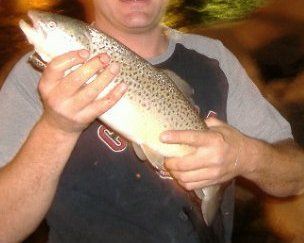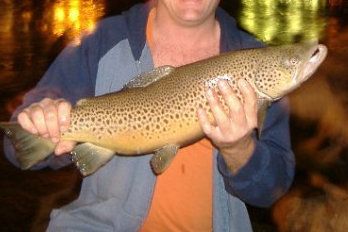Brown Trout
Salma trutra Linnaeus
The brown trout originally came from various European areas. In the scientific name, Salma is the Latin for the salmon of the Atlantic and trurta for trout.
Eggs of the Loch Leven trout were brought to the United States from the Howieton Fishery, Stirling, Scotland, in 1884. The Loch Leven trout differs somewhat in colour and markings from the typical brown trout, but it is now considered to be merely a local form of that species.
In any case, it is improbable that any pure strains of the Loch Leven brown trout exist on this continent. The body of the brown trout is typically trout-like, and, in the breeding males, the teeth and hooked snout are strongly developed. In general, the ground colour of the body is golden brown with dark brown or black spots on the body, dorsal, adipose and a few on the tail fin. Some body spots are edged with orange, and some below the lateral line are edged with pink or red, forming halos. Colours are most brilliant in spawning males.
Identification may be made easier if we look for points of difference rather than for similarities. For example, immature Atlantic salmon, steelhead rainbows in many lakes and brown trout in a number of lakes may have strikingly similar, bright, silver coloration with x-shaped black spots on the body, but browns will have yellowish pectoral fins and a tinge of red on the adipose fin. The caudal lin of the rainbow trout is heavily spotted whereas the caudal lin of the brown trout has few spots.
The chars (Salvelinus) are characterized by a peculiar boat-shaped structure, the vomer, in the roof of the mouth. In the genus Salvelinus, the teeth on the vomer are restricted to the head of this bone, whereas, in the genus Salma, the teeth are well-developed and extend well down the shaft of the vomer
Distribution
The brown trout is native to the streams of western Europe and the British Isles. It has been artificially propagated and distributed in New Zealand, Africa and America. In North America, introductions have been as follows: United States, 1883 ; Newfoundland, 1884; Quebec, 1890; Ontario, 1913; New Brunswick, 1921; and Nova Scotia, later. In l9l3, brown trout fingerlings were introduced in the Speed River in the vicinity of Hespeler, in streams in the vicinity of Simcoe, Norfolk County, and in streams in the vicinity of St. Paul’s, Perth County.
Plantings under private auspices may have been carried out prior to 1913. By means of these and subsequent plantings, brown trout fishing has been provided in several streams in southern, agricultural Ontario rather than in the rock-bound lakes and rapid streams of northern Ontario. They are caught in fair numbers in the Humber, Credit, Speed, Grand, Saugeen, Sydenham (Grey County), Nottawasaga and Muskoka Rivers.
Habitat
Brown trout need clean, coldwater to satisfy their living requirements. In southern Ontario, they frequent pools or ponds fed by streams. They can adapt themselves to somewhat warmer water than that tolerated by our native trout.
They seem to do best in water that does not exceed 80°F _ Although they hold their own in many turbulent, fast-flowing streams, they appear to show a preference for quiet placid waters like those of their native home in England, France and Germany.
However, experience has shown that practically all streams that are suitable for brooks are suitable for browns. This adaptation to cold water and rapidly flowing streams brings them into direct competition with our native brook trout.
Habits
Movements: After spending the first two or three years of life in the stream, the brown trout may move out into the lake. And, where it has become established, like other members of the genus Salma, it may enter the sea.
Spawning: The importance of tributary streams in the life cycle of our stream-spawning trout cannot be over-emphasized. Brown trout have been known to spawn in wide, deep streams and in comparatively small streams. Normally, the stream spawner seeks the cool tributary streams where there is an abundance of clean gravel and rubble bottom in the riffle areas. The migration to the breeding area takes place in late.
October and early November, about the same time as the eastern brook trout.
Females dig pits in the loose gravel and rubble, using their tails and bodies as excavators. Large females may dig three or four pits up to 12 inches deep in an area which may extend 20 to 30 feet along the stream bottom. Each pit is constructed so that a current is set up within it. Eggs and milt are extruded simultaneously, and the eggs are covered with gravel and rubble by the female. A large female will lay over 3,000 eggs. During the spawning act, males defend their territories against the intrusion of rivals or of enemies.
Food: Up to four inches in length, the brown trout feed primarily on insects. Larger fish also take insects and prey upon fish to a considerable extent, especially when they leave the streams and move out into the lake. Growth is much faster in the lake than in the stream. The feeding habits of brown trout differ in some respects from those of the brook trout taken from the same stream. Probably the most striking difference is the large number of mayflies consumed by the brown trout. Caddisflies, two-winged flies and beetles appear to be much less acceptable to brown trout, judging by the small percentages of these foods which occur in stomachs. Observations appear to indicate that brown trout feed more at the surface than brook trout.























